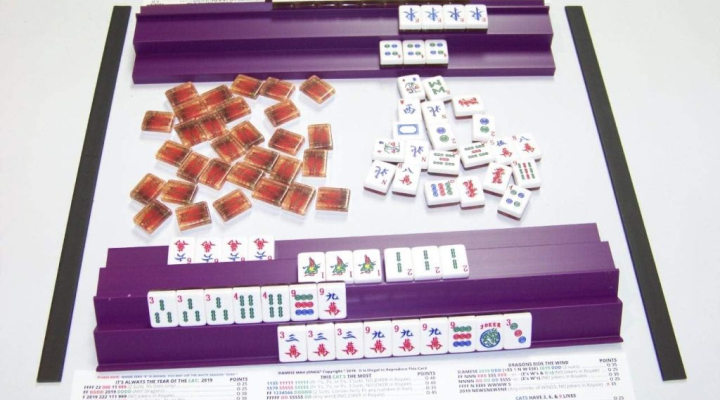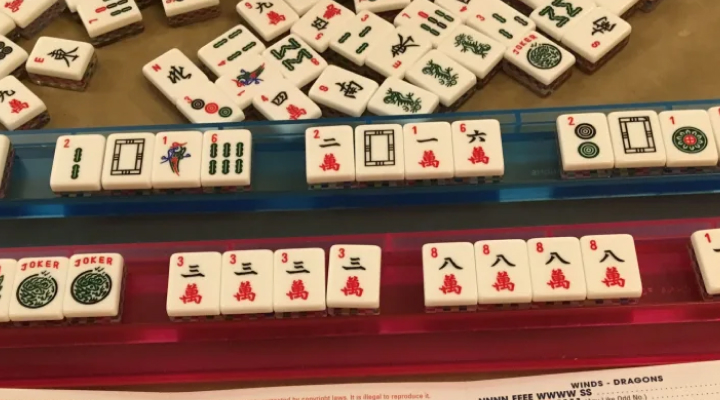Siamese MahJong or Mahjong for Two Hands
Date:
Updated:
Table of Contents
Table of Contents
How to play mahjong with 2 players? Two Handed Siamese Mah Jongg™
How to play mahjong with 2 players?
The 2-handed game of SIAMESE MAH JONGG was created in April 2015, by Gladys Grad. Gladys is well-known in the U.S. Mah Jongg world as the foremost authority of American-Style Tournament Mah Jongg. Mah Jongg Madness and Gladys, as the owner and tournament Director for several large-scale tournaments throughout the Country, helped to formulate and standardize the Rules for National Mah Jongg Tournaments.
These rules have been published with permission by Gladys Grad.

Two Handed Siamese Mah Jongg™
There is absolutely no reason to have to play a drawn-out or less thought-provoking game with only two players. You will love this simple yet very challenging method of playing Mah Jongg. It can be fast, stimulating, and fun, fun, fun.
Rules of Two Hands Mahjong
1. TWO PLAYERS/TWO RACKS EACH
- Two players face each other; and place 2 racks in front of each player.
2. WALLS.
- Build two (2) full walls of tiles, 19 stacks long, parallel to each other. (EASY OPTION: You can build one wall against each rack. When the tiles from the outside rack have been used, just move that rack behind the other rack.) EVEN EASIER OPTION: Don’t build any walls. Just leave the shuffled unpicked tiles on one side of the table, and discard on the other side of the table.
3. OPTIONAL:
- EAST THROWS THE DICE TO BREAK THE WALL. East throws the dice to break the first wall arbitrarily, and retains the amount of tiles corresponding to the dice throw (as with the standard 4-handed version of MJ). It is an OPTION to use the dice to arbitrarily break the wall (Except in Siamese Tournaments). Dealing/picking will commence from East’s walls.
4. 28 TILES FOR EAST, 27 TILES FOR THE OPPOSITE PLAYER:
- Each player deals themselves four (4) tiles from one of the two (2) walls in front of East, until East has taken their last four (4) tiles which would give East 28 tiles. Player opposite then takes three (3) tiles, which gives him/her 27 tiles.
5. ARRANGING THE TILES.
- Players may arrange their tiles on both their racks…as many as desired; and may exchange tiles back and forth between their own racks .It does not matter how many tiles are on each rack at any one time. (See Item 9).
6. CHARLESTON.
- There is NO Charleston. (NOTE: You have plenty of tiles and a multitude of tile combinations over which you have control.)
7. THE GAME BEGINS.
- East discards the 28th tile to begin the game; then the opposite player picks their first tile from the wall; then discards a tile; and so on. Picking and discarding proceeds.
8. JOKERS.
- You may exchange your own Jokers from your own exposures, or from your opponent’s exposures; but you can NOT exchange a Joker from any existing EXPOSED Mah Jongg hand. Jokers may be exchanged from exposures in a “dead” hand, IF that exposure did not cause the hand to be declared “dead.”
9. MAH JONGG.
- Once a Mah Jongg is declared by a player, and that player has discarded a tile to complete their turn, that rack with the Mah Jongg exposed must hold only 14 tiles. STRATEGY NOTE: The disadvantage of not exposing your own MJ is that the game might finish before you have declared your own Mah Jongg; and you must have a Mah Jongg exposed in order to be paid. You won’t be paid for a MJ that is still IN your rack, not ON your rack. However, once your first Mah Jongg has been declared and exposed, you MAY NOT exchange for those exposed Jokers. The longer you delay declaring a Mah Jongg and exposing those tiles, the longer you are able to use your own Jokers interchangeably. Remember, once the Mah Jongg hand has been exposed and declared, the Jokers in the exposure can NOT be exchanged.
10. YOU ARE PLAYING BOTH RACKS INTERCHANGEABLY.
- Even though the TILES ARE INTERCHANGEABLE on the racks, players must be cautious to NOT put their exposures on the WRONG Rack. Remember, the tiles are interchangeable IN the racks, not ON the racks. A player’s hand should be declared “dead” if the exposures do not match a hand on the NMJL card. However, the player may continue playing to try to build a 2nd Mah Jongg on their 2nd rack.
11. IF PLAYER IS DECLARED “DEAD” FOR 2 HANDS, THE GAME CEASES
- “Dead” player pays opponent 4 times the value of opponent’s existing Mah Jongg, or 4 times the lowest value on the card – whichever is relevant.
12. PLAYER HAS 1 MAH JONGG AND 1 DEAD HAND
- The game continues by the opponent only – until opponent makes a second Mah Jongg, or all the tiles have been picked. (NOTE: In a 4-handed version, the “dead” player has to cease playing, while everyone else continues. Think of the player’s 2 racks in the 2-handed version as 2 individual players. If one hand is “dead,” there are still 3 players alive.)
13. GAME CEASES
- when 1 player has declared 2 MAH JONGGS or when the tiles from the walls have been used, and the last discard has been made.
14. If a player has a rack that is declared “dead,”
- player may continue to exchange tiles between the two racks, but may NOT USE the tiles from the exposures that MADE the HAND “dead” – in order to build another hand. However, Jokers may be exchanged from exposures in the “dead” hand, only if that exposure did not cause the hand to be declared “dead.”
15. SCORING AND PAYOUTS:
Payments are made at the END of the game. For easy payouts, keep score. At the end of the game, the lesser score will pay the winner the difference between the two (2) scores,
- The 1st Mah Jongg by a player receives the value on the NMJL card, regardless if it is self picked, but if it is JOKERLESS, the value is doubled. Reminder: The Payer is not penalized for throwing a tile that is claimed for MJ.
- If both players have the same score for their 1st Mah Jonggs, e.g., a 25 point hand – then the payment will be a “wash.”

If a player declares and wins with two (2) Mah Jonggs, the payout for the 2nd Mah Jongg is doubled, regardless if it is self-picked. Payout is doubled again if the 2nd Mah Jongg is JOKERLESS (excluding singles and pairs).
